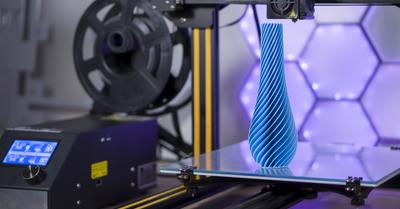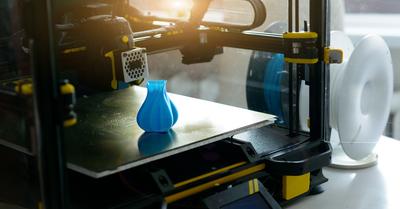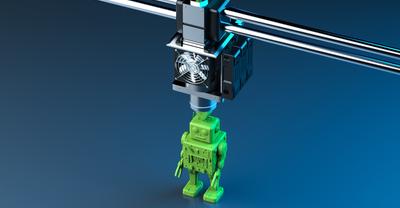PLA
Poly-lactic acid, or PLA, is one of the most environmentally friendly filaments used in 3D printing, as it is a biodegradable plastic. This material is derived from sustainable sources such as:
- Cornstarch
- Potatoes
- Sugarcane
- Cassava
Unlike other oil-based materials, which usually contain petroleum, these components differentiate this kind of filament and help it biodegrade faster without leaving toxins behind.
Pros of PLA
PLA is one of the most common materials used in 3D printing because it is inexpensive and readily available on the market. A one kg spool of PLA filament will often cost less than $25 and is available from retailers such as Amazon and even Walmart.
PLA is also a popular choice due to its sustainability. It is made from plant-based sources and can be composted quickly and without harming the environment.
PLA breaks down into lactic acid components, commonly used in skincare products and food preservatives.
Another reason users prefer PLA filament is because it does not produce harmful fumes while printing. Instead, it produces a rather sweet scent.
The basic technology behind 3D printing is about heating plastics to their melting temperature. As a result, many other types of material can produce unpleasant, or even noxious, fumes during the process.
PLA is popular with beginner 3D printers as it has a low handling temperature, around 180 ̊ to 210 ̊ C which is significantly lower than other printing filaments. This lower temperature helps save on power and energy costs, while also being compatible with most basic 3D printer components.
The low handling temperature also helps increase the filament’s flexibility without causing warping, making it versatile for many projects. PLA can bend to create sturdy, hard pieces with sharp corners or rounded edges easily.
Cons of PLA
Because PLA is a low-temperature material, it is less resistant to high heat and other natural elements.
Many users have learned this the hard way by leaving their printed object in a hot car or direct sunlight, only to return to a melted puddle of plastic.
This is indicative of PLA having poor longevity due to its biodegradable properties.
Objects made from PLA filament will lose strength over time and naturally degrade, especially when used in an outdoor setting exposed to the elements and temperatures.
Additionally, PLA is very brittle due to its hardness.
This means PLA objects will not stand up to repeated or continuous force and will snap easily.
Below is a summary table of these pros and cons for PLA filament.
PROS
- Inexpensive cost
- Sustainable plant sources
- Biodegradable
- Low handling temperature
- No noxious fumes
- Flexible, low warping
CONS
- Less resistant to high heat and elements
- Poor longevity
- Brittle and can snap easily
PETG
PETG stands for Poly-ethylene terephthalate glycol, which is a mouthful but simply means it is a glycol-enhanced version of standard PET plastic.
This can be found in many single-use recyclable plastics and consumer goods. This fact means PETG is indeed food safe.
The added glycol in this material helps keep the filament from being cloudy and weak and increases the final product’s aesthetic.
Pros of PETG
PETG is often seen as the middle ground filament, between PLA and some of the more industrial-strength materials such as ABS. This filament maintains durability and heat resistance while still being easy to use for printing.
The printing temperature is approximately 230 ̊ to 250 ̊ C, which is significantly higher than PLA.
Many of the useful properties of PETG are due to the added glycol.
This helps the material be more transparent, and results in the final product having a smooth and glossy finish.
This transparency also means with the proper post-processing, PETG can create transparent 3D printed objects. PETG can also be easily colored or silk-screened.
The glycol also helps PETG have a high amount of chemical resistance, meaning projects made with PETG filament are incredibly durable and long-lasting even with harsh sanitizing measures.
PETG resists degradation by UV radiation and other natural elements, which is a marked difference between this material and PLA filament.
The impact resistance and flexibility of PETG make this material functional and versatile for many uses, including for objects that must hold up to continued applications of force.
The tensile strength of PETG is around 7700 psi. This material is much less brittle than PLA.
Because PETG comes from a standard plastic PET, this material is recyclable. It also does not emit any unpleasant odors during the printing process.
PETG is slightly more expensive than PLA but still lies in an affordable range between $25 and $50 for the filament’s 1kg spools.
Cons of PETG
As PETG is such a strong and tough material, it can be more difficult to obtain a clean finish during post-processing.
Options include heat treatment or manually sanding and polishing the object as it is naturally resistant to mechanical or chemical finishing methods.
PETG does have a softer exterior, which can lead to negative effects such as stickiness. The stickiness can lead to stringing on the object when excess material is melted and sticks to the layer.
This can be fixed by using a heat gun to melt and remove the strings or otherwise slowing down the cooling process to prevent the strings from permanently bonding to the object.
The stickiness of PETG can also lead to the material fusing to the print bed. This makes it important to coat the printing surface with a releasing agent to prevent damage to the print bed.
Another drawback of PETG is the reaction to temperature and humidity.
While PETG is more temperature-resistant than PLA, it is still sensitive to very high humidity and heat. PETG is considered hygroscopic, meaning it is absorbent and can be damaged in damp situations.
Luckily this can be addressed by completely drying your PETG product, perhaps in the oven, before using it.
Below is a chart to summarize the major pros and cons of PETG.
PROS
- Higher heat and UV resistance
- Naturally transparent, glossy finish
- High level of chemical resistance
- Less brittle; holds up to repeated force
- High impact resistance
- Flexibility
- Recyclable material
CONS
- Difficult to post-process
- Softer exterior
- The final product can be stringy
- Sensitive to dampness and humidity
Best Uses of PLA Versus PETG
Having covered the benefits and drawbacks of both PLA and PETG, we can now address for which types of projects each filament is best suited.
PLA’s Uses
PLA is great for projects that must be detailed and post-processed, such as models and prototypes. PLA is also the best choice for a beginner 3D printer looking to experiment. It is easy to work with and inexpensive.
PLA is also available in a variety of colors and designs, including color-changing or glittery filaments.
Due to its sustainability and safety, PLA is also a good choice for food-safe products such as containers or drinking straws.
Be aware, though, that since PLA is less heat-resistant, it is not suitable for hot drink cups.
PLA has been used for implants and skin-absorbable stitches in the medical field due to its biological compatibility.
When to Use PETG
PETG is better for tougher jobs that must withstand higher heat and force levels, such as items that will be used outdoors.
This being said, PETG is not suitable for industrial-level projects.
Because of its translucent properties, PETG is great for packaging, where the product must be showcased.
PETG is also food-safe as it is BPA-free. So, it can be used in consumer products such as drinking bottles and food storage containers.
PETG can withstand repeated harsh sterilization, which has made it popular in medical device packaging, prosthetics, and the pharmaceutical industry.
Printer Compatibility
Over the last ten years, the 3D printing industry has shifted from revolving around research and development of the technology to being more widely applied in a diverse range of uses such as:
- Medical and dental
- Aerospace
- Automotive
- Industrial and manufacturing
- Art and design
- Consumer products
Both PETG and PLA can be used in the most common type of 3D printer, a Fused Filament Fabrication (FFF) printer.
The FFF printer heats the thermoplastic near its melting point. Once the filament is at temperature, it extrudes from a nozzle, which traces the cross-section for each layer of the object.
This process repeats, layer after layer until the object is fully formed
Fused filament fabrication printers are the most commonly used types of printer and are often referred to as Fused Deposition Modeling or FDM printers.
These printers are generally the less expensive type and therefore are widely used for personal, and business uses.
Best 3D Printers for PLA and PETG
This list is comprised of the best PLA and PETG compatible 3D printers for various needs and budgets.
- QIDI TECHNOLOGY X-One 3D Printer – Best Budget and Small-Space Option
This inexpensive Qidi Tech offering is a fully enclosed single-extruder 3D printer. It has high versatility, accepting both PLA and PETG filament and other versions such as ABS and TPU.
This small 3D printer is a great option for students, educators, and novices looking for a budget-friendly beginners’ option. The printing area is 5.5 cubic inches making it perfect for small parts. At approximately 14”h x 15” w x 11” d, this machine is small enough for personal use in a home or apartment.
This printer offers a 3.5-inch touch screen and comes completely assembled. The Qidi Tech X-One model has a sturdy metal frame and a heated print bed to help adhere to materials during the printing process.
At under $300 from most retailers, this 3D printer is a steal. There is no sacrifice for quality or price, as this model is high-quality for an affordable price.
- Sindoh 3DWOX 1 3D Printer – Best Mid-Range Option
This mid-range 3D printer by Sindoh is an enclosed, single-extruder model.
The flexible metal print bed allows print jobs to safely adhere during the print job and easy removal without scraping once the printing process is done.
The Sindoh 3DWOX model runs for around $1,500, but the versatility and quality of this 3D printer are worth the higher price point.
This printer works with PLA, PETG, and many other filaments and materials. The open-source mode makes it easy to use these alternatives, depending on the project’s requirements.
This model is better for a more professional-grade or detailed printing project.
With a large 7-inch touchscreen, Wi-Fi compatibility, and 300x300x305mm build volume, this option is a step up for those who want to improve their 3D printing abilities.
There are numerous convenient features such as filament auto loading and assisted print bed leveling to make this model very user-friendly.
Another great feature of this 3D printer is its low noise level. At 40db, that is equivalent to a library noise level giving you the ability to print through the night without being disturbed.
- Raise 3D 101016001 Pro2 3D Printer – Best High-Performance Option
At just under $4,000 for this Raise 3D model, this printer is for those with higher budgets seeking a professional-grade, fully enclosed model with dual extrusion and versatility. This option is great for those working in:
- Aviation
- Medical
- Architecture
- Industrial design
The Raise 3D Pro2 printer accepts nearly all types of filament materials, including PLA and PETG.
The hot end can reach up to 300 ̊ C, which allows the printer to handle heat-sensitive materials.
Although this is a printer geared for professionals, it is a turn-key product allowing users to print their largest projects right out of the box.
With a large build area of 300x300x305mm, a 7-inch touch screen, and wireless compatibility, this option is perfect for experienced 3D printers.
The HEPA filter ensures no dust or particles will disrupt or ruin the printed objects.
Best PLA and PETG Filament Manufacturers
As PLA and PETG filaments are both relatively inexpensive 3D printing materials, it can be difficult to tell which brands are the best quality for your printing projects.
This list gives examples of some of the biggest and best filament manufacturers offering PLA and PETG materials.
This California brand offers a huge variety of 3D printing accessories and materials, including PLA and PETG. This company is popular due to its fast and free shipping, high-quality customer support, and free consulting services.
Matterhackers has a great array of color and design options, including glow in the dark filaments. Their most popular selections are the PRO Series and Build Series, which both have PLA and PETG options.
Matterhackers is relatively affordable, with most 1kg filament cartridges costing between $20 and $40.
ColorFabb is based in the Netherlands and is well-known in the 3D printing industry for its good quality filament, but this good quality does come with a higher price tag.
ColorFabb also offers a service called Color on Demand, a custom color formulation for completely unique projects.
Popular ColorFabb product lines include their nGen, a standard PETG filament, and nGen Lux, which is PETG filament with a sparkly finish.
Makerbot is a New York-based 3D printing brand with high-end products and quality customer service.
Their materials are popular for home and office use, and the PETG and PLA lines come in a variety of colors.
One caveat with this brand is that their materials are on the pricey side, as they are offered in bulk quantities.
This is a U.K.-based company that offers a huge range of colors and designs.
Some of their more unique filaments include metal-infused PLA, natural wood design filament, and satin or matte finishes in many colors.
If you are unsure of what colors you want or are looking to experiment, 3D FilaPrint also sells sample boxes, including assortments of randomly selected colors in either heated or cold-bed formats.
Be aware that since this manufacturer is based in the U.K., American customers will have to order through a third-party provider such as Amazon.
Concluding Thoughts
PLA and PETG filaments both come with their pros and cons and are both suitable for varying needs. If you’re new to 3D printing, your best course of action is to experiment with each type of filament to gain first-hand knowledge of how it works and determine which product will work best for your projects.









